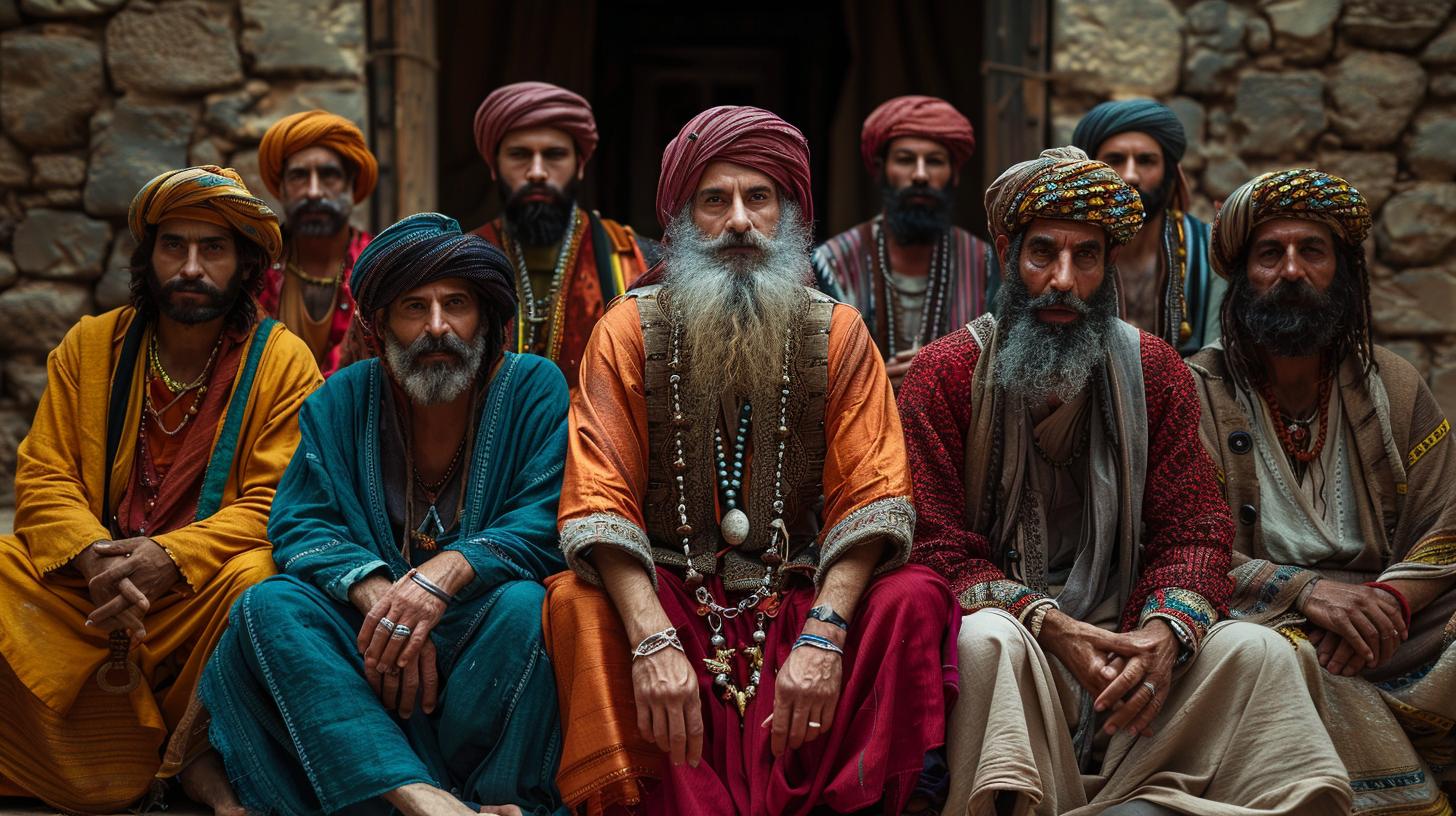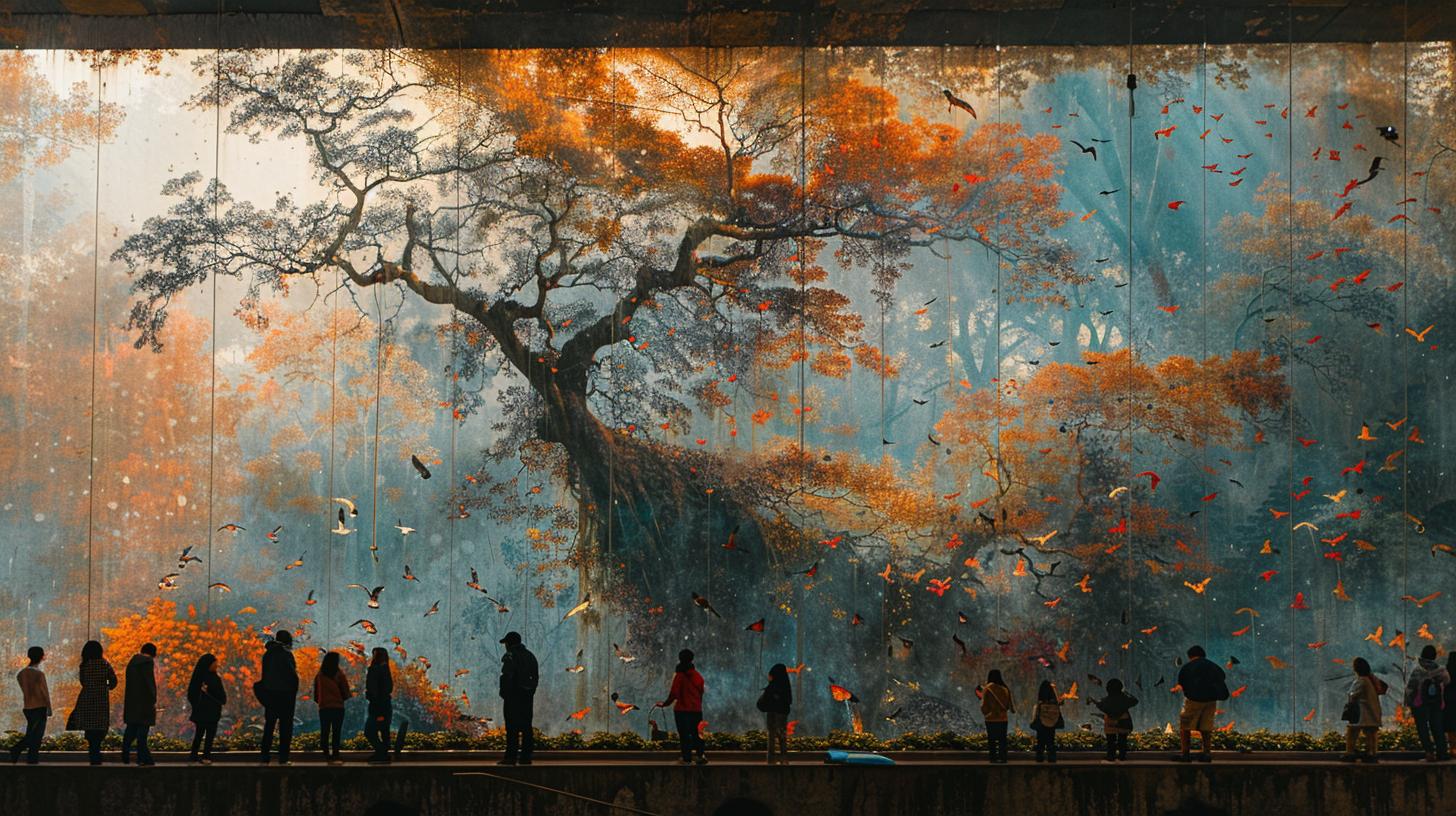Exploring the Rich Tapestry of the 12 Tribes of Israel Through Art

The story of the 12 tribes of Israel is stitched into the very fabric of history, interweaving strands of culture, belief, and heritage that span thousands of years. These tribes form a central component of Jewish historical identity and are integral to the narrative found within the Hebrew Bible. Their tales have shaped traditions and religious practices for countless generations, establishing a foundation upon which much of Jewish culture rests.
Beginning with the patriarch Jacob, also known as Israel, and his twelve sons, each tribe developed its distinct community. Over time, these communities grew in both size and influence, leaving an indelible mark on the course of history. The fascination with these ancient tribes has endured through the centuries-not just within textual accounts or oral traditions but also manifesting splendidly within countless works of art.
Art offers a unique lens through which to explore and reinterpret these historical narratives. Through creative expression across diverse media-from ancient frescoes and intricate tapestries to modern sculptures and abstract paintings-artists have endeavored to capture the essence and individuality of each tribe.
By examining how different periods and cultures depicted these fabled origins through art, we gain a deeper insight into their symbolic significance as well as their enduring impact on both past societies and our contemporary world. As we embark on this visual journey across artistic mediums, let us uncover how artists over millennia have portrayed the rich tapestry woven by the 12 tribes of Israel.
The Origins and Symbolism of the 12 Tribes of Israel
The 12 tribes of Israel are a cornerstone of Jewish history, each one representing the sons and grandsons of the patriarch Jacob, who was also known as Israel. Their story began when Jacob blessed his sons, providing them with prophetic insights which would eventually define their individual legacies.
These tribes became identifiers for family lineages and political entities within the ancient Hebrew society. The foundation of these tribes is chronicled in the Torah or the Hebrew Bible, primarily in the Book of Genesis and extending into Exodus, Numbers, and beyond.
Each tribe developed its unique symbolism that held significant importance in religious texts and cultural traditions. Over time, these symbols have been vividly represented in various artistic mediums. For instance, Juda – often symbolized by a lion – denotes leadership and strength.
Levi’s symbol is the breastplate of judgment or ephod representing spiritual guidance as they were designated priests serving in the Temple. Artists have often employed these emblems as focal points within their works to encapsulate both tribal identity and associated virtues.
Historically, art has served as a means to communicate complex ideologies through imagery. The representations of tribes vary substantially from one creation to another but maintain consistency with each tribe’s traditional emblem or motif; ranging from natural elements like water for Zebulun to architectural forms like gates for Issachar. Through artwork spanning multiple centuries, both religious rituals carried out by different tribes and secular aspects such as professions historically undertaken by members of specific tribes have been immortalized.
| Tribes | Traditional Symbols |
|---|---|
| Judah | Lion |
| Benjamin | Wolf |
| Levi | Breastplate/ Ephod |
| Naphtali | Hind/Deer |
| Zebulun | Ship/Nautical Imagery |
This array of symbols tied to the legacy of each tribe enables artists through history to tell stories that are richly layered with meaning and significance from different angles-whether allegorical depictions in stained glass windows or intricate adornments on ritual objects-and continue to inspire interpretations up to modern times.
The Evolution of Depiction
Artifacts of Antiquity and the 12 Tribes
The historical artifacts that first depicted the 12 tribes of Israel offer crucial insights into the dawn of this cultural cornerstone’s artistic representation. These early works range from architectural relics found in ancient synagogues to ornate ritual objects, each serving an essential role in the day-to-day lives of those who belonged to the tribes. Initial depictions were often quite literal, showing visual interpretations of biblical descriptions or symbols.
Among these are mosaics and frescoes that have been unearthed during archaeological excavations, where symbols such as lions, eagles, and serpents emerge to represent Judah, Dan, and Levi. These symbols encapsulate not only tribal identity but also convey narratives filled with spiritual meaning.
Artistic Transformations Through the Centuries
As history unfolded, so too did the portrayal of the 12 tribes within art. During the Renaissance period, a renewed interest in biblical themes led artists to bring their own interpretations and stylistic nuances to this subject matter. The portrayal of Jacob’s sons became a common motif for demonstrating both artistic skill and religious expression.
In paintings and frescoes created by masters such as Tintoretto and Rembrandt, each son’s character was explored deeply – sometimes intertwining astrological associations which were prevalent during certain historical periods. Additionally, European stained glass artisans meticulously crafted vivid images that would illuminate chapels with colored light filtered through representations of each tribe.
Modern Interpretations’ Artistic Freedom
The evolution from these traditional expressions has led us into modern times where contemporary artists have reinterpreted the ancient tales associated with the 12 tribes of Israel with greater freedom and diversity. The stories and attributes associated with each tribe provide ample material for expression across a range of media – from painting to digital art forms there is no limit to how these age-old stories can be told anew.
Interestingly, even within Judaica-a realm deeply rooted in tradition-the depiction of tribal elements progresses stylistically while respecting its origins’ sanctity; here lies one aspect in which artistic innovation pairs with historical fidelity for compelling results.
These modern renditions demonstrate not only changes in aesthetic preferences over time but also reflect shifting societal attitudes about religion, mythos, culture, and identity itself; all factors contributing significantly towards an ongoing dialogue between past lore and present creativity when mediating upon twelve very special heritages inscribed both upon sacred texts and human imagination alike.

Stitching Together Culture and Faith
Unraveling Threads in Sacred Garments
Textile art has long been an integral part of Jewish culture and religion, providing a fabric-based canvas for the rich stories of the 12 tribes of Israel. Historically, each tribe was associated with specific colors and emblems, as outlined in ancient texts like the Bible, and these symbols were often woven into religious garments such as the High Priest’s breastplate or ephod – each stone representing a different tribe.
The meticulous craftsmanship involved in creating these garments reflects their importance in ceremonies and the direct connection to divine worship. Today’s textile artists continue this tradition by embedding traditional tribal motifs into their work while also infusing contemporary elements that speak to modern interpretations of faith.
Tapestries Telling Timeless Tales
Tapestries have served as large-scale narrators of the tales and teachings of the 12 tribes throughout history. These intricately woven pieces can be seen adorning the walls of synagogues, museums, and homes as decorative elements that are also imbued with educational significance.
Among the threads are portrayed scenes from Jacob’s blessings over his twelve sons, depictions of tribal camps from biblical narratives or prophetic visions such as those found in Ezekiel or Revelations where tribal symbols play a seminal role. The tactile nature of textiles brings these stories to life in high detail; each stitch contributes to an overall visualization that engages observers not only visually but also through the sense of touch.
Embroidery and Identity: Sewing Symbolic Connections
Moving beyond tapestries, embroidery holds its own unique place within Jewish textile art related to the 12 tribes of Israel. Hand-stitched prayer shawls (tallitot) may contain stripes or corner designs inspired by tribal iconography: lions for Judah, trees for Asher, or waves for Zebulun represent just a fraction of these symbolic interpretations. The personalization of such items bridges communal identity with individual expression, allowing adherents to proudly display their heritage during worship and daily life alike.
Contemporary embroidered works carry on this legacy while potentially incorporating modern styles or themes-promoting dialogue between past traditions and current societal contexts. Each time an artist chooses needle and thread to depict one of Israel’s tribes, they perpetuate not just a historical narrative but also a physical connection to that enduring lineage which continues to inspire followers across generations.
Painted Legacies
The rich cultural and religious history of the 12 Tribes of Israel has found an enduring canvas in the world of iconography and paintings. Portraying biblical narratives and carrying deep-seated symbolism, these visual arts play a pivotal role in narrating the story of each tribe. Various artists throughout the centuries have turned to their palettes and brushes to bring to life the unique traits and tales that symbolize these ancient peoples.
- Visual Narratives: Artists have painstakingly crafted visual stories that capture key moments from the lives of the tribes’ ancestors, such as Jacob blessing his sons or Moses dividing the land among the tribes. Each painting becomes a historical chapter, detailing aspects like territorial inheritances, moments of divine intervention, or prophecies that shaped their destinies.
- Symbolic Representation: Certain colors and motifs recur across different artworks as symbols for individual tribes. For instance, Judah is often depicted with a lion, reflecting its status as a dominant tribe; Issachar with a strong donkey laden with books symbolizes scholarship; while Joseph is frequently shown with sheaves of wheat or a multicolored coat representing his dreams and his father’s favoritism.
- The Artist’s Touch: The interpretations by various artists allow us to see through their eyes how they envision each tribe’s character – sometimes focusing on raw humanity, other times elevating them with an air of divine purpose. This variety offers viewers multiple lenses through which to understand these ancient communities.
Through different periods such as the Renaissance or Baroque era, emphasis on certain themes shifted. In early Christian art, for example, depictions were focused more on creating literal translations from text to canvas. However, later periods sought to depict figures like King David or Solomon-both linked to particular tribes-in grander compositional settings reflecting their historical significance and prophetic roles.
Alternatively, post-Renaissance works brought forth new perspectives illustrating deeper allegorical meanings inherent within tribal narratives. Baroque painters would use dramatic lighting and stark contrasts (chiaroscuro) not only for visual appeal but also to evoke emotional responses correlating to spiritual themes woven into each tribe’s legacy.
As we move further away chronologically from these biblical times into modern days, we find that contemporary artists continue exploring this subject matter too. These present-day creatives often seek out unique ways in which they can connect past wisdoms with current day-to-day realities through innovative artistic styles – be it through abstractionism or hyperrealism.
The continued fascination with depicting the 12 Tribes of Israel underscores their undiminished importance in cultural discourse – not just within Jewish heritage but as archetypes resonant across humanity’s diverse tapestry.
The study and appreciation of these painted legacies invites observers into a deeper reflective space where both artistry meets tradition and where color blends seamlessly with faith – ensuring that this integral aspect of oral histories is forever preserved within visible frames for future generations.
Contemporary Canvas
In recent art, the 12 tribes of Israel continue to be a significant source of inspiration for modern artists who bring fresh perspectives and contemporary contexts to these ancient narratives. The tapestry woven by their interpretations adds vibrant threads to the historical and cultural significance this subject holds within both Jewish and Christian communities.

Many contemporary artists look to the rich symbolism associated with each tribe as a wellspring for creativity, delving into themes ranging from unity and division, heritage, and identity.
- Artist Yael Kanarek has incorporated the names of the 12 tribes into her multimedia installations, exploring linguistic connections and how they inform identity.
- In contrast, artist Sigalit Landau uses motifs drawn from her Jewish heritage to comment on modern issues such as borders and displacement, reflecting some of the challenges faced by the tribes in historical texts.
- Multidisciplinary artist Kehinde Wiley is known for his vivid, large-scale portraits that confront viewers with a blend of contemporary African-American subjects styled in traditional Jewish iconography, connecting disparate timelines and cultures while potentially referencing tribal lineage.
These artists exemplify how complex sentiments about culture can be conveyed through artistic movements like abstract expressionism or conceptual art. They continue the dialogues started eons ago by incorporating symbols like the Lion of Judah or Menorah, which are traditionally linked to specific tribes. The choice of these symbols elicits emotional responses grounded in religious devotion or cultural affiliation while also opening discussions about broader social issues.
Contemporary interpretations extend beyond simple visual representation, embedding narratives relevant to our times within their works. For instance:
- Through video installations combining archival footage with new recordings or digital manipulation, artists explore concepts like migration and homeland-a direct correlation with the overarching narrative concerning land allocation among the tribes.
- In painting series’, varying aesthetics reflect upon individuality versus collectivism inherent in tribe identities-potentially critiquing contemporary societal division.
- Sculptural pieces reimagine tribal symbols utilizing industrial materials or found objects, commenting on sustainability or globalization’s impacts on culture.
The enduring allure of depicting the 12 tribes through various media proves that these ancient icons retain relevance in today’s artistic expression. Their stories have seamlessly transitioned from mosaic law tablets and temple walls onto canvases ripe with digital manipulation or crafted through experimental sculptural techniques. Contemporary creators utilize this deeply storied motif to question our past’s connection with present societal landscapes-an interplay between epochs that ensures continuous rejuvenation for both historic legacies and current art discourses.
Sculpted in Stone and Imagination
Sculptures and installations offer a tactile dimension to art that allows the viewers to experience form, space, and the narrative of the 12 tribes of Israel in a three-dimensional context. Heritage and spiritual symbolism are carved not only in stone but also shaped through various materials like metal, wood, and even modern synthetics. The essence of the tribal identities as descendants of Jacob is given a unique physicality that often bridges history with contemporary reflection.
Artists have found ingenious ways to interpret the ancestral stories of the 12 tribe of Israel within sculptures and installations. Some evoke traditional iconography while others seek abstraction to symbolize theological concepts and cultural connections.
This mosaic of interpretations ensures that each tribe’s uniqueness-as integral strands in the Jewish historical fabric-is honored through visual mediums. These works range from life-sized statues personifying individuals from each tribe to abstract pieces that capture collective experiences or pivotal moments from biblical history.
| Material | Interpretation |
|---|---|
| Stone | Permanent, classical representations depicting scriptural scenes or figures. |
| Metal | Durable works utilizing bronze or steel; can incorporate kinetics for a modern twist. |
| Wood | Natural material often used for warmer, more organic sculptures. |
| Synthetics | Innovative mixed media installations using plastics, resins, etc. for contemporary forms. |
| Interactive Elements | Components allowing audience engagement; may include sound, movement, or digital interactions. |
Interweaving Art and Education
Art serves as a powerful vehicle for education, capturing the imagination and curiosity of its audience. This is particularly true when it comes to relaying the storied past of the 12 tribes of Israel. Through creative expression, artists have been able to convey complex historical and religious narratives that could otherwise be challenging to comprehend. Art inspired by these tribes offers a unique opportunity not only for aesthetic appreciation but also for learning about their diverse cultural heritage.
By incorporating the symbols and stories associated with the 12 tribes of Israel into visual forms, educators can evoke interest in biblical history and Jewish tradition among students and art enthusiasts alike. Educational programs often harness such artworks as tools to engage participants in discussion, allowing them to explore ancient texts in a more approachable way.
For instance, seeing a painting or tapestry that illustrates Jacob blessing his sons, from whom the tribes descended, can inspire a deeper conversation about patriarchal traditions and their lasting influence on modern-day Jewish identity.
Interactive workshops and exhibitions are growing in popularity as they provide hands-on experiences with art related to the 12 tribes. These sessions may include creating personal renditions of tribal symbols through various artistic mediums or recreating scenes from key historical moments connected to the tribes’ journey.
Not only do these activities reinforce learning through active participation, but they also help embed this ancient narrative within contemporary culture. As people construct their works of art-be it through drawing, painting, or even digital media-they imbue the story of the 12 tribes with fresh perspectives and interpretations that keep these ancestral tales vibrant in today’s society.
Conclusion
It is through the realm of art that the narratives and essence of the 12 tribes of Israel can be vividly brought to life, ensuring that their legacy endures and continues to inspire. The tapestry of artistic expression weaves together countless threads from different eras, styles, and perspectives, creating a living representation that transcends time itself.
This dynamic interplay between art and the storied history of the tribes serves not only as a visual feast but also as a testament to the enduring human spirit to preserve culture and faith through creativity.

Art in its myriad forms offers a unique lens through which we can view the cultural, religious, and historical importance that each tribe holds. Whether encapsulated in intricate textile designs or portrayed with bold strokes upon a canvas, each piece serves as a repository for collective memory and identity. The stories of each tribe are told anew with each artist’s interpretation, inviting contemporary audiences to connect with an ancient lineage in ways that are both profound and deeply personal.
Moreover, these artistic endeavors act as silent ambassadors for Jewish heritage, instructing and fascinating all those who encounter them. For some viewers, such works might provoke curiosity leading to further exploration; for others, they may resonate on an intimate level due to shared ancestry or faith.
It is within this diverse spectrum of engagement that the broader significance of such art finds fertile ground. As new generations encounter these creative depictions of tribal history and symbolism, they encounter vibrant pathways into understanding their past-and thereby shaping their future-with renewed appreciation for both where they have come from and where they might go.
Further Readings and Viewings
As we peel back the layers of history and tradition that surround the 12 tribes of Israel, it becomes clear that art has played a crucial role in both preserving and celebrating their legacy. Throughout this article, we have seen how various forms of artistic expression have provided a window into the past, allowing us to witness the evolution of representation and symbolism associated with these legendary tribes.
To continue exploring this rich cultural tapestry, one could engage with museums worldwide that house collections of Judaica and historical artifacts relevant to the 12 tribes. Institutions such as The Israel Museum in Jerusalem offer extensive exhibitions where ancient relics meet contemporary artworks inspired by the tribal narratives. Additionally, The Jewish Museum in New York often features exhibitions on Jewish history which include elements relating to the tribes’ heritage.
Further understanding may also be deepened through specialized online resources. Websites such as The Bezalel Narkiss Index of Jewish Art provide a database of Jewish iconography that can be an invaluable resource for those wishing to explore imagery associated with each tribe individually. For more modern interpretations, artists’ personal websites or online galleries present a platform for contemporary creators who reinterpret tribal themes within their works.
Additionally, those keen to see new interpretations can look out for traveling exhibitions and installations that focus on this subject matter. These events not only showcase existing works but also sometimes lead to the creation of new pieces-an auspicious sign that the spirit of creativity kindled by the stories of the 12 tribes continues to thrive.
The living narrative woven by artists through every brushstroke, thread, and carved stone is more than just depiction-it’s an invitation. An invitation to engage with a journey that transcends time; to seek out firsthand sensations; to connect with an identity steeped in millennia yet pulsating vividly within today’s cultural landscape.
Thus, whether you are passionate about history, religion, art or all three combined, diving into this creative journey offers a unique understanding far beyond what words can convey-a personal encounter with a collective memory inscribed upon humanity’s vast canvas.
Frequently Asked Questions
What Are the 12 Tribes of Israel in the Bible?
The twelve tribes of Israel in the Bible are named after the sons and grandsons of Jacob, who was also known as Israel. These tribes are Reuben, Simeon, Levi, Judah, Issachar, Zebulun, Dan, Naphtali, Gad, Asher, Joseph (whose tribe was divided into two through his sons Ephraim and Manasseh), and Benjamin.
Which of the 12 Tribes of Israel Still Exist?
The concept of the existent tribes of Israel is complex, as they were historically dispersed or assimilated following conquests and exiles. However, some Jewish communities throughout the world trace their lineage back to various tribes.
Notably associated are the Jews claiming descent from Judah (hence “Judaism” and “Jew”) and Levites including both Levites and Kohanim (the priestly class). The other tribal identities have largely been lost due to historical circumstances.
What Tribe Was Jesus From?
According to the New Testament in the Christian Bible, Jesus hailed from the tribe of Judah. This claim is particularly significant for Christians because it fulfills Old Testament prophecies that a descendant of Judah would be a messianic figure.
Who Are the 12 Sons of Jacob in Order?
Jacob’s twelve sons in birth order start with Reuben followed by Simeon, Levi, Judah, Dan and Naphtali from Bilhah and Zilpah—Jacob’s concubines—then Gad and Asher continue this line from these two women. Following them are Issachar and Zebulun while Joseph comes second to last with Benjamin being the youngest sibling.
What Do the 12 Tribes of Israel Represent?
The twelve tribes represent both a literal family descending from Jacob’s children as well as deep symbolic significance within Judaic tradition; each tribe has been associated with unique blessings or traits based on Jacob’s blessings found before his death alongside Moses’ later blessings.
Collectively these groupings provide structure for ancient Israelite society cultural divisions representing a fuller body metaphorically while holding historical-real accounts too.
What Tribe Was Moses From?
Moses was from the tribe of Levi which was set apart for religious service among the twelve tribes of Israel within their social structure where no territorial inheritance in Canaan allocated instead receiving certain urban enclaves amongst other tribal lands satisfying needs engaging temple/tabernacle duties mostly due to Aaronic hereditary priesthood lines therefrom.
Who Are the Israelites Today?
Modern Israelites essentially refer to citizens or nationals within contemporary State of Israel encompassing various ethnicities not solely limited ancestral groups biblically denoted furthermore diaspora Jewry around earth at large having diverse genetic socio-religious backgrounds but often united under Judaism whether by conversion blood ties or culture alike often seeking roots possibly linked original Hebrew populace millennia ago regardless elusive authentic lineage proofs today yet maintaining identity factors regardless.
Who Are the 12 Tribes in Revelation 7?
In Revelation 7 John lists revised enumeration 12 tribes sealing 144000 servants God end times listing excluding traditional tribe Dan whilst splitting Joseph into Ephraim Manasseh separately countering original Genesis grouping thereby sparking numerous interpretations theological debates amongst scholars earnest readers about meanings these changes allegorical aspects depicted therein future prophetic events anticipated based texts therein.





